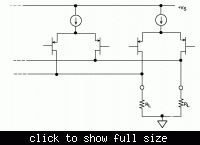allanvv
Advanced Member level 4
In the schematics I've seen for current-steering DAC's, the switch is the same type of FET as the current source FET's. Why is this?
If we have PMOS current sources, the output voltage can go close to ground. Then it seems like an NMOS transmission gate should work better, since NMOS gates can pass low voltages but PMOS gates can't.
If we have PMOS current sources, the output voltage can go close to ground. Then it seems like an NMOS transmission gate should work better, since NMOS gates can pass low voltages but PMOS gates can't.
